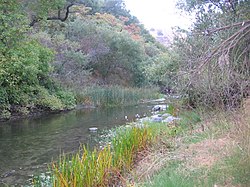
Sunol is an unincorporated area and census-designated place in Alameda County, California. Located in the Sunol Valley of the East Bay, the population was 913 at the 2010 census. It is best known as the location of the Sunol Water Temple and for its historic tourist railroad system, the Niles Canyon Railway.
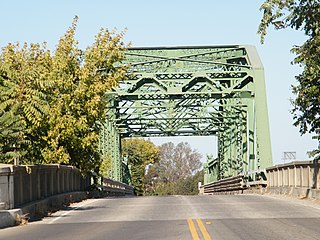
Lathrop is a city located 9 miles (14 km) south of Stockton in San Joaquin County, California, United States. The 2020 census reported that Lathrop's population was 28,701. The city is located in Northern California at the intersection of Interstate 5 and California State Route 120, in the San Joaquin Valley.

The Altamont Corridor Express is a commuter rail service in California, connecting Stockton and San Jose during peak hours only. ACE is named for the Altamont Pass, through which it runs. Service is managed by the San Joaquin Regional Rail Commission, and operations are contracted to Herzog Transit Services. The 86-mile (138 km) route includes ten stops, with travel time about 2 hours and 12 minutes end-to-end. In 2022, the line had a ridership of 389,100, or about 2,200 per weekday as of the second quarter of 2023. ACE uses Bombardier BiLevel Coaches, MPI F40PH-3C locomotives, and Siemens Charger locomotives.
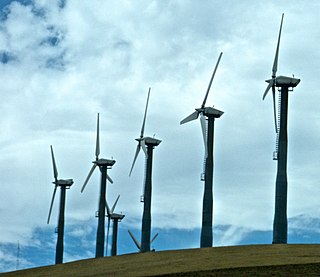
Altamont Pass, formerly Livermore Pass, is a low mountain pass in the Diablo Range of Northern California between Livermore in the Livermore Valley and Tracy in the San Joaquin Valley. The name is actually applied to two distinct but nearby crossings of the range. The lower of the two, at an elevation of 741 ft (226 m), carries two railroad rights-of-way (ROWs) and Altamont Pass Road, part of the old Lincoln Highway and the original alignment of US 50 before it was bypassed c. 1937. The bypass route travels over the higher summit, at 1,009 ft (308 m), and now carries Interstate 580, a major regional highway heavily congested by Central Valley suburbanization.
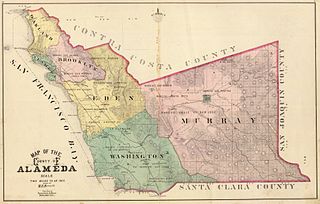
Murray Township was a township located in what is now the Livermore Valley portion of Alameda County, California, including the present day cities of Livermore, Dublin, and Pleasanton, and the census-designated place of Sunol.

Alameda Terminal was a railroad station and ferry wharf at the foot and west of present-day Pacific Avenue and Main Street in Alameda, California, on the eastern shore of San Francisco Bay with ferry service to San Francisco. It was built in 1864 and operated by the San Francisco and Alameda Railroad. In 1869, it served as the original west coast terminus of the U.S. First transcontinental railroad, until the opening of Oakland Pier two months later. The western terminus was inaugurated September 6, 1869, when the first Western Pacific through train from Sacramento reached the shores of San Francisco Bay at Alameda Terminal, — thus completing the first transcontinental railroad "from the Missouri river to the Pacific ocean" in accordance with the Pacific Railroad Acts.

The first Vallejo Flour Mill, in the Niles district of Fremont, California, was built in 1841 by José de Jesús Vallejo (1798–1882), elder brother of General Mariano Guadalupe Vallejo, on his Rancho Arroyo de la Alameda, along with a dam and aqueduct to power it. The Flour Mill was located at the mouth of Niles Canyon, then called Alameda Cañon, which served as the major course of Alameda Creek. A second Flour Mill was built in 1856, the stone foundation of which may still be seen today.
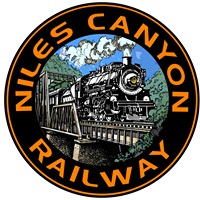
The Niles Canyon Railway (NCRy) is a heritage railway running on the first transcontinental railroad alignment through Niles Canyon, between Sunol and the Niles district of Fremont in the East Bay of the San Francisco Bay Area, in California, United States. The railway is listed on the National Register of Historic Places as the Niles Canyon Transcontinental Railroad Historic District. The railroad is operated and maintained by the Pacific Locomotive Association which preserves, restores and operates historic railroad equipment. The NCRy features public excursions with both steam and diesel locomotives along a well-preserved portion of the first transcontinental railroad.
Addison Cook Niles was an attorney and served as Nevada County judge in California from 1862–1871 and as associate justice on the Supreme Court of California from 1872–1880.
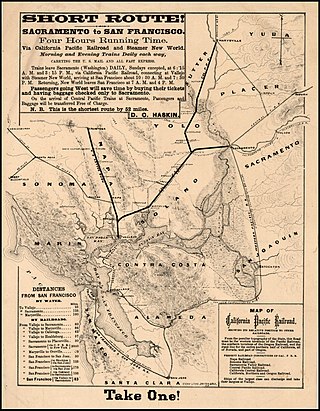
The California Pacific Railroad Company was incorporated in 1865 at San Francisco, California as the California Pacific Rail Road Company. It was renamed the California Pacific Railroad Extension Company in the spring of 1869, then renamed the California Pacific Railroad later that same year. Its main line from Vallejo to Sacramento was completed six months prior to the May 1869 golden spike ceremony of the Central Pacific/Union Pacific Transcontinental Railway.

The Solano was a large railroad ferry, built as a reinforced paddle steamer with independently powered sidewheels by the Central Pacific Railroad, that carried entire trains across the Carquinez Strait between Benicia and Port Costa in California daily for 51 years, from 1879 to 1930. When launched, the Solano was the largest ferry of its kind in the world, a record held for 35 years until 1914 when she was joined by her sister ship, the Contra Costa, which was 13 feet (4.0 m) longer.
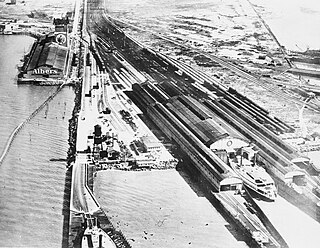
The Oakland Long Wharf was an 11,000-foot railroad wharf and ferry pier along the east shore of San Francisco Bay located at the foot of Seventh Street in West Oakland. The Oakland Long Wharf was built, beginning 1868, by the Central Pacific Railroad on what was previously Oakland Point. Beginning November 8, 1869, it served as the west coast terminus of the First transcontinental railroad. In the 1880s, Southern Pacific Railroad took over the CPRR, extending it and creating a new ferry terminal building with the official station name Oakland Pier. The entire structure became commonly and popularly called the Oakland Mole. Portions of the Wharf lasted until the 1960s. The site is now part of the facilities of the Port of Oakland, while passenger train service operates at the nearby Jack London Square/Dellums Station and another nearby station in Emeryville.
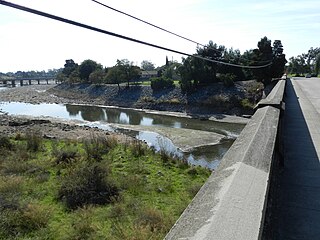
Alameda Creek is a large perennial stream in the San Francisco Bay Area. The creek runs for 45 miles (72 km) from a lake northeast of Packard Ridge to the eastern shore of San Francisco Bay by way of Niles Canyon and a flood control channel. Along its course, Alameda Creek provides wildlife habitat, water supply, a conduit for flood waters, opportunities for recreation, and a host of aesthetic and environmental values. The creek and three major reservoirs in the watershed are used as water supply by the San Francisco Public Utilities Commission, Alameda County Water District and Zone 7 Water Agency. Within the watershed can be found some of the highest peaks and tallest waterfall in the East Bay, over a dozen regional parks, and notable natural landmarks such as the cascades at Little Yosemite and the wildflower-strewn grasslands and oak savannahs of the Sunol Regional Wilderness. After an absence of half a century, ocean-run steelhead trout are able to return to Alameda Creek to mingle with remnant rainbow trout populations. Completion of a series of dam removal and fish passage projects, along with improved stream flows for cold-water fish and planned habitat restoration, enable steelhead trout and Chinook salmon to access up to 20 miles (32 km) of spawning and rearing habitat in Alameda Creek and its tributaries. The first juvenile trout migrating downstream from the upper watershed through lower Alameda Creek toward San Francisco Bay was detected and documented in April 2023.
The San Francisco and Oakland Railroad (SF&O) was built in 1862 to provide ferry-train service from a San Francisco ferry terminal connecting with railroad service through Oakland to San Antonio. In 1868 Central Pacific Railroad decided that Oakland would be the west coast terminus of the First transcontinental railroad and bought SF&O. Beginning November 8, 1869, part of the SF&O line served as the westernmost portion of the transcontinental railroad. It subsequently was absorbed into the Southern Pacific Railroad (SP). The track in Oakland was electrified in 1911 and extended across the San Francisco-Oakland Bay Bridge in 1939. Service was abandoned in 1941.
The San Francisco and Alameda Railroad (SF&A) was a short-lived railroad company in the East Bay area of the San Francisco Bay Area. The railroad line opened 1864–1865 from Alameda Terminal on Alameda Island to Hayward, California, with ferry service between Alameda Terminal and San Francisco started in 1864. After being bankrupted by the 1868 Hayward earthquake, it was acquired by a subsidiary of the Central Pacific Railroad in August 1869. Part of the SF&A line between Alameda Terminal and San Leandro served as a portion of the First transcontinental railroad starting in September 1869, while the southern section was abandoned in 1873.
The Western Pacific Railroad (1862–1870) was formed in 1862 to build a railroad from Sacramento, California, to the San Francisco Bay, the westernmost portion of the First transcontinental railroad. After the completion of the railroad from Sacramento to Alameda Terminal on September 6, 1869, and then the Oakland Pier on November 8, 1869, which was the Pacific coast terminus of the transcontinental railroad, the Western Pacific Railroad was absorbed in 1870 into the Central Pacific Railroad.
Laddville is a former settlement in the western Livermore Valley of Alameda County, California.

The Tri-Valley-San Joaquin Valley Regional Rail Authority is a special-purpose district body formed for the sole purpose of providing a public transit connection, known as Valley Link, between broad-gauge Bay Area Rapid Transit (BART) and standard-gauge Altamont Corridor Express (ACE) services, in Northern California.
The Oakland Subdivision is a Union Pacific Railroad line in the U.S. state of California. It extends from Stockton in the east to Oakland, crossing the Diablo Range at Altamont Pass and traversing Niles Canyon. The line was originally built by the Western Pacific Railroad as the final Pacific leg of their Feather River Route — it was acquired by Union Pacific upon their purchase of Southern Pacific. For its length, the line largely parallels the route of the First transcontinental railroad, the Western Pacific Railroad (1862–1870), though the Subdivision was laid out decades after the Western Pacific.
